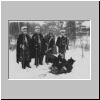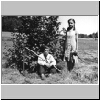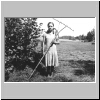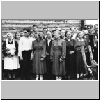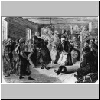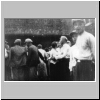| blank
|
CUSTOMS AND TRADITIONS > YOUTH TRADITIONS YOUTH LIFE How did the youth community function within the annual cycle? By Advent major works of the year had been finished. In eastern Lithuania, St.Andrews Day traditionally marked the beginning of Advent. On this day girls forecasted what was going to happen to them in future. In the greater part of Lithuania, dances and songs were forbidden during Advent. Almost in all Lithuania youths gathered on fixed days (on Saturday or Sunday, or sometimes on both days) to engage in games. In spite of Advent, young people played merry games. Sometimes such games had a shade of eroticism about them. Boys treated girls in a more free way than during youth parties. On workdays game parties were replaced by evening gatherings. Girls played the role of hostesses. Female neighbours span, did embroideries, and wove sashes. Boys sporadically made ropes or did some woodcarvings. Usually they just sat doing nothing or playing cards. Sometimes they annoyed girls to make them drop their handiwork and engage in games. After Advent evening games were quite often replaced by Saturday dances. In some places they were held even daily. The jolly mėsėdas (the period from Christmas till Shrove Tuesday during which special emphasis was laid on eating meat) started. Youth community assembled under one roof again. On Christmas Eve youths once more engaged in fortune telling, especially about weddings. Christmas was an important event in youth life in all Lithuania. Hired workers returned home, their service period being over. As part of youths married in autumn, the somewhat shattered youth community consolidated in the Tarpušventis period (from Christmas till Three Kings Day) to experience the time of its utmost activity. In many places, a custom of daily gatherings to have fun and enjoyment existed. Such merrymaking was common even on workdays. In some places, merry processions of costumed people through villages lasted all 12 days. In quite a big area of north-eastern Lithuania, a custom of going Gypsy existed. Boys not only fooled around playing Gypsies but also teased girls and poured water on assembled people. Somewhat rude attentions were shown to girls in Kapsai when asking šyvis to dance (šyvis means a person wearing a mask of a horse). This custom must have come from Germany. However the main purpose of such processions was to honour neighbours and to collect food for a subsequent party. The Three Kings procession crowned the last day of the Tarpušventis period. During the mėsėdas the oldest and most active youths usually left youth community. The monotony of evening parties of that time was broken by farewell gatherings to honour friends and by wedding ceremonies themselves. Even in the interwar period they could be attended by uninvited quests in the greater part of Lithuania. Shrove Tuesday, the last holiday of the mėsėdas period, stirred young people. It closed the wedding season. Village boys assembled to organise processions of costumed people. Such processions marched through the villages of almost a half of Lithuania. They were much noisier and less reserved than Christmas parades. Holiday parties were held in almost the whole country. As in other countries of West Europe, costumed people tried to buy senmergės (unmarried women), bergždininkės (female persons or animals without children), to check whether they were fat enough. They made them kiss the ground through their aprons, or poured consecrated water on them, or smoked them by means of a pot with live coals, or pricked their hands with a nail or a needle hidden in the mask, etc. Unmarried girls, too young to belong to the abnormal category of spinsters, suffered. Such erotic, even obscene behaviour was impossible during other seasons (except flax breaking or St. Johns Day in some places). On the other hand, such behaviour was dictated by archaic beliefs that secured the interests of village community in former times (assurance of fertility). However with the loss of sacral meaning of the rite, the act degraded into the sphere of entertainment. Thus instead of teasing spinsters or bergždininkės, boys pestered girls whom they wished to court a little, often neglecting old bachelors completely. Aggression displayed by male youths during Shrovetide activated youth community powers only temporarily. Shrove Tuesdays festivities marked the beginning of the monotonous Lenten fast. Dances and merrymaking during this time was forbidden. Fast coupled with the end of weddings and evening parties, and the loss of a certain number of youth community members made youth life stagnant. At that period youth community activities were the weakest. The passive and monotonous Lent period linked Shrovetide and Easter together. Easter consolidated male youths again. However this was observed in the eastern part of Lithuania rather than in the western one. Masks and special costumes would vanish. Girls would be treated quite differently. The youthful character of village youth community manifested itself as early as on Palm Sunday. In the second quarter of the 19th century several males, juniper twigs in their hands, walked through villages hitting girls with them. This custom existed in Suvalkija and in the western part of Aukštaitija. Its purpose was to make girls promise to give them margučiai (dyed eggs) on Easter. Real Easter festivities started on Easter Eve. At night the so-called Easter Jews (correspondingly costumed people) literally romped about the church. Not only young girls but also elderly women suffered from them. On the night of the first day of Easter boys assembled to perform the ritual of lalavimas (walking through the villages singing and playing music). Only young males could participate in it. Usually they stopped to wish each family a good year, harvest and health. If there were marriageable girls in the family, they performed a special song, the so-called lalinka for them (around Gervėčiai it was called zaklėtunga). Boys wished the girls to become married and to get a good husband. Sometimes even a costumed matchmaker participated in the procession. The singers were rewarded for the bringing honour to the girls. Most often they were given dyed Easter eggs and other food or drinks. Easter lalavimas is a specific youth custom. It is seldom observed in Europe. As can be seen, girls, teased, disregarded and labelled spinsters or barren beings during Shrove Tuesday, would again receive honours as potential brides on Easter. Girls salutation is possibly related to the transference of certain social roles. Other customs support this hypothesis. On the third day of Easter girls became more active. In the central part of Lithuania they acquired a right to pour water on boys (boys poured water on girls on the preceding day). May festival was held on the third day of Easter in the central part of Lithuania. During the festival the most beautiful girl was selected. She in her turn chose three boys she liked best. She danced and exchanged gifts with them. Later they addressed each other as brothers and sister. In some places girls exchanged visits treating guests to a cake. Special sacral functions were reserved for girls also in spring invitation customs. Such customs existed in the 19th century. Around April, girls had a chance to get into the focus of attention of village community by means of performing a sacral function of inviting spring. The beginning of spring being declared, a party was organised. This custom existed longer in regions inhabited by Slavs. Social activity of girls manifested itself also in St. Georges Day customs. In the areas surrounding Gervėčiai musicians were hired not by boys but by girls. That evening girls invited boys to dance. Spring invitation practices were possibly related with the customs that existed in the north-eastern part of Lithuania till the interwar period. Fourteen days after St. Georges Day girls celebrated the so-called Terpjurginės (period between St. George's Days according to the Gregorian and the Julian Calendar) holiday. Around Švenčionys, Tverečius and Adutiškis girls and sometimes women gathered together. To welcome spring, they climbed on fences or hills and sang. The priority of girls social activity is evidenced also by Whitsunday festivities, the last major holiday held to mark the end of spring. On that day both male and female youths gathered together for ritual merrymaking, that is for sambariai, kupolės and parugės. Participants of such feasts had to bring their share: each girl would bring some cheese, sausage, a couple of eggs, while each boy - a bottle of whiskey or beer. Exceptional character of girls status can be seen in the gathering called Kupolės. Around Tverečius in the 3rd quarter of the 19th century, witnessed that girls were more active than boys, though village community tolerated a more free behaviour of youths during village community festivities. It was the girls who made wreathes for boys or gave them flowers as presents. Boys gave flowers to girls as a sign of gratitude, or as a present to their beloved ones, while girls often gave wreathes to any boy who attracted their attention. At the end of the 19th century girls organised separate girls gatherings in the area around Kupiškis. During the gatherings they wove wreathes, decorated themselves with flowers and engaged in fortune telling. In the north-eastern part of Lithuania girls performed one more public function. While shepherds celebrated Whitsunday holidays girls looked after the cattle. In the morning girls drove cattle into the pasture. Boys would come to help them. In such a way non-intensive labour would turn into entertainment. Sometimes youths played at wedding beside a rye field. A bridegroom was selected from the most gallant boys, and a bride - from the most dashing girls. (Sometimes the selected bridegroom would choose the bride). The entire wedding ritual was replicated. In this way the management structures of youth community were formed. Church festivals held in spring increased the vernal activity of girls. They also strengthened their chances to demonstrate physical and social maturity. Girls had a chance to show themselves during parish youth parties and to go without any restrictions to parties held in other villages. Girls were not allowed to go to the parties held outside the boundaries of their native village. In the interwar period such chances were significantly widened by gegužinės, an innovation of the end of the 19th century. Gegužinė means a public youth party in the open. It was symbolised by a field with birch-trees planted or driven into the ground alongside. Young people from several villages or even a parish participated in this festivity. The first gegužinė was usually held on Whitsunday. Though in spring girls initiative obviously prevailed in village community life, the male part of youth community formed at the same time. This is evidenced by the fact that in spring boys initiation rites were usually performed. In Žemaitija where the rites had disappeared the hierarchical structure of the male part of youth community would start taking its shape as early as at the time of manuring, the first bee of the year. Men would try their force engaging in fighting, lifting each other, etc. Helpers who participated in the collective manuring for the first time or boys who had come from other villages would be noticed on that occasion. Parties that followed after collective work offered a chance to enjoy fun on a work day. At the close of the 19th century, youth couples had to be formed before St. Johns Day. By the beginning of summer works, youth community had to be regenerated. The management structures of youth community had to be formed completely, which was necessary to perform a special function of youth as the most mobile age group able to fulfil emergency agricultural works efficiently. In some places of Lithuania, the regenerated composition of youth community was consolidated by St. Johns Day customs. In certain places the character of youth interaction and customs resembled those practised during Whitsunday. For example, at the beginning of this century, a custom of clubbing together resources and holding a youth feast existed in Klaipėda region. Girls honoured boys named John giving each of them a sash and a pair of gloves. In some places of Suvalkija boys were wreathed like on Whitsunday. In the middle of the 19th century, in Aukštaitija, near the Pabiržė parish, girls chose the place for St.Johns Day celebration. At the beginning of the 20th century, in Rokiškis district, girls even invited boys for the first St. Johns Day dance. A record from Lithuania Minor dated 1932 states that on the eve of St. Johns Day girls of each village gathered together to go to the fields in several groups. When such groups from different villages met they greeted each other singing special songs. Girls wreathed a kopolis (a barked-up pole decorated with greenery like a Maypole) stuck into the ground near a corn field. They danced around it and guarded it against boys two nights and one day. In comparison with St. Georges Day - Whitsunday period, on St Johns Day the male part of youth community was obviously more active. Records made several decades later evidence that boys would assemble to frighten the singing girls at night. At the end of the 19th century in north-eastern Lithuania males resorted to acts of violence towards girls. They even poisoned them by means of drugs intended for animals. The girls could respond to such violence only with the irrational love magic of St. Johns Day. However in the greater part of Lithuania activity of youths of both genders was balanced. During the feast by the bonfire youths of both genders interacted as members of one family. This is evidenced by the custom of jumping over the bonfire in pairs that existed in western Lithuania and in Lithuania Minor. (If the girl did not like the boy she refused to jump). People believed that if the jump was successful, the couple married that year (which usually happened). A search for a fern flower was usually practised in northern, western and southern Lithuania. This custom was also performed in group. In Žemaitija and northern Lithuania, the fixed standards of behaviour were sporadically disregarded on such an occasion. Couples would leave the group to look for the so-called fern flower without any witnesses. This added another functional meaning to the custom. In terms of mood, original youth hay harvesting gatherings were in line with St. Johns Day festivities. In comparison with the manuring season, careless, noisy, and rough by nature, hayharvesting was more serene: youths of both genders dressed up for work, boys even tried to work by their girls side. As young couples had formed by St. Johns Day, whole attention could be given not to courting but to the consolidation of youth community. Meadows were usually located some distance away from the village, so common trips to work consolidated village males especially. Maybe this was determined by the fact that in the neighbouring Poland youths were admitted to youth community during hay harvesting. Rye harvesting was especially important to girls. In eastern Lithuania where rye was reaped by women, baravedė (lead harvester) was in the lead, her section was the broadest ... other girls tried to catch up with her. When both genders started to participate in rye harvesting, boys took the initiative. The first section was cut by the best harvester often called pirmininkas (lead harvester). The boy who lagged behind others risked his honour greatly, especially if other harvesters drove him away. There was intense competition between boys and girls. As autumn, the wedding season, was near, youths tried to demonstrate their prowess for work in every possible way. Such abilities and skills proved their qualifications for socially responsible life. If rye was reaped by women, youths again, like on St. Johns Day, engaged in predicting their fortune in marriage. When reaping girls looked for a double-eared rye keenly. They believed that this secured their getting married or being lucky in general throughout the coming year. On the other hand, the girl who reaped the last sheaf was believed to give birth to a bastard. A wreath symbolised not only the end of work and the beginning of feast or collective work party. It also symbolised a qualification for marriage. The ceremony of wreath carrying was another ritual function of youths, namely girls. The procedure was solemn. For example, in some places of Suvalkija a harvest wreath was carried by the leading reaper (a potential bride). She was escorted by two maids and six horsemen. Youth interaction during flax pulling was a kind of extension of rye harvesting gatherings. During flax pulling youths qualifications for marriage were also stressed. People believed that marriage was secured for those girls who pulled or threw the last sheaf, or found a two-stem plant. During flax pulling the hierarchical structure of girls community was stressed, girls coming into the focus of attention of village community. The status of baravedė, a leading harvester, was exceptional: other helpers would scold her, jeer at her or praise her and sing songs to honour her. Nevertheless they always showed certain respect to her. Other girls tried to work as well as she did. They competed with one another. Those girls who lagged behind or were less skilled at flax pulling were mocked at. During the harvest feast the baravedė was seated in a special place. The host gave her presents for her efforts. The collective work mood prevailed also during collective work party. In the regions where flax growing was most intensive the baravedė was wreathed. In northern Suvalkija and north-eastern part of middle Lithuania boys tried to seize the wreath. In Zanavykai region there was the following custom: girls did not dance until the wreath had been seized. As can be seen, the communal activity of girls on calendar holidays in spring was replaced by their efforts to become the best female workers in summer. Similarly, girls wish to be noticed in spring was replaced by the wish to be married in autumn. (Autumn offered good economic opportunities for organising major feasts. For this reason wedding parties were often held in autumn). When creating a family, much attention was paid to the persons ability to do field work efficiently. Work done in pairs modelled the skills of economic activity necessary in married life. Marriage magic practised by girls during flax pulling was supported by a kind of challenge to the male part of youth community. During flax pulling girls teased boys by singing songs that revealed boys defects. Girls made the so-called štoberis, a special bouquet representing male genitals. During thrashing season girls threw a ladle into a mow at the risk of being packed into a big sheaf of straw. This custom existed in many places of Lithuania. Possibly, the purpose of such behaviour was to provoke boys aggression during flax breaking. As flax breaking was performed at night, it offered a chance of telling horror tales and frightening girls. In general, flax breaking marked the beginning of a wedding season characterised by a more free behaviour, competitions, and declaration of boys courage, strength, agility, and resourcefulness. The exceptional time of flax breaking, possibly related to the relics of archaic holidays, determined the erotic character of work and leisure activities. Like on Shrove Tuesday, bergždininkės would be bought, only the boys would behave more erotically. Such theatrical acting on the part of boys could be even treated as a kind of sexual violence. The theatrical ceremony of killing of a bergždininkė (that is of a she-goat) included her embracing, health checking, pinching, putting across the so-called ožys (he-goat) (a device to fix a flax-breaker), her symbolic killing by bloodletting, taking off her apron, public caresses performed by a žydas (a Jew), obscene comments about her body parts. The so-called wedding of Joskė and Sorė, and other theatrical performances with the regular costumed characters of winter holidays created a chance of teasing girls in a rather rude way. Such practices as binkiavimas, birokavimas (when several boys seized the girl firmly and ran her seat against a flax-breakers fixing device), or šaudymas (shooting) (when boys gave a smart kick in the back part of the girls sabots to knock them down into a heap of boon ), or covering her face with soot had similar character. However actions of social violence were directed not only at girls. The problem of origin of Kuršis ( a straw effigy representing evil spirits) or the problem of the functional meaning of Kuršis carrying deserves a separate study. This custom seems to have a deleterious character. At the risk of being unmercifully beaten (which sometimes resulted in death), having to work day and night without any pay, being mocked at and disgraced (sometimes Kuršis carrier was undressed leaving only the jacket on him with a pole put through its sleeves), a boy performed a bold deed - threw a straw bugbear into a neighbouring thrashing barn - covering himself with short-lived glory. Similar deeds, for example steeling bergždininkės from a group of helpers had similar character. Free behaviour marked even feasts and merrymaking organised on the completion of hard work. In Žemaitija people even tried to make girls drunk. The more drunk the girls, the better the flax harvest. Such an idea was common there. During flax breaking feasts foul language and free behaviour reached its climax. Such things were not characteristic of feasts marking the completion of works other than flax breaking. The eroticism of flax breaking events, however ten times weaker, was evident in parties and gatherings of Advent that closed the cycle of calendar year. At the close of the 19th century, due to technological innovations, the greater part of ancient agrarian traditions vanished. Calendar customs also changed. Today Christian traditions tend to acquire ethnic character. The ideological policy pursued by the USSR resulted in the fact that the confessional identity of grandparents failed to be accepted by grandchildren or was accepted by them only partly. Even the customs of annual Christian holidays (Easter and Christmas) are perceived as national ones. Sitting by the traditionally laid table with traditional Easter or Christmas dishes on it, many youths do not even think of going to a High Mass or taking an Easter nights watch in the church. Whitsunday traditions, so rich fifty years ago, have practically disappeared. Easter and Christmas holidays, immensely popular in the interwar period, were replaced by the New Year festivities actively promoted in the Soviet times. However The New Year incorporated the symbols representing the frame of reference in time perception only. Positions occupied by Easter and Christmas were shaken by the decline of Advent and Lent traditions. As is known, they promote serenity and abstention. Some culture houses currently abstain from organising dances only in the first and the last week of Advent or Lent. On the other hand, other changes in calendar traditions can be noticed. All-Lithuanian holidays are created. Dzūkai celebrate Shrove Tuesday in a Samogitian manner; St.Johns Day is solemnly marked in places where it has not been celebrated since the beginning of this century. Such process could be seen also in the interwar Lithuania. Lithuanias independence regained, especially after 1926, attempts were made to stress the honourable position of Lithuania through the image of St. Johns Day. This holiday had to counterbalance confessional differences of various regions of Lithuania and to take root in Klaipėda district. The future of Lithuania Major and that of Lithuania Minor had to be united through the symbols of honourable past. Thus the tendency of decline of this holiday was checked. St. Johns Day became the annual holiday of influential youth and adults organisations (such as Jaunalietuviai (young Lithuanians) League and Šauliai (Shots) Union). The area of distribution of St. Johns Day even widened. Today, alongside with Lithuanian national holidays, youth is willingly accepting the traditions of western holidays. Owing to the influence of mass media, culture houses and even school, St. Valentines Day has become one of the most popular youth holiday. Judging by newspaper and magazine publications, only Christmas and New Year do a little better than St. Valentines Day. Traditional marriage seasons that once regulated the cycle of social activity of youth community members have disappeared. The number of marriages per month is distributed equally throughout the year. So, the traditional annual youth community cycle is destroyed. Only separate elements of the cycle have been preserved. They still attract investigators attention urging the promotion of tourism in rural areas of Lithuania.
|
blank |
| PREVIOUS |
